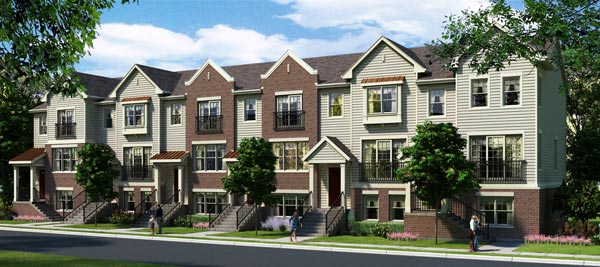
Lexington Homes (Lexington Park in Des Plaines pictured here) in May launched a “Homeseller Assistance Program”
In the good old days (that is, a couple of years ago), buyers of new homes still under construction had a period of at least several months in which to sell their older home while waiting for the new one to be finished. But now, with a lot of new residential inventory standing ready to go, Jeff Benach, a builder, has found that most potential buyers show up at his developments in Wheeling, Des Plaines, and Bridgeport before they have even put their current home on the market.
“They’re sitting on it because they don’t know what they can get for it,” says Benach, the head of Lexington Homes. “They’re reluctant to put it on the market and see prices fall [even though] they want to move to a new home.”
Like pretty much every developer right now, Benach has units complete and ready to hand over. (You can read about Benach’s Lexington Square project in Bridgeport in the monthly Deal Estate column in Chicago’s July issue, which hits newsstands next week.) So it’s in Benach’s interest to see potential buyers get their present homes sold so they can pay for one of his. To help make that happen, Lexington Homes in May launched a “Homeseller Assistance Program” that offers prospective buyers two incentives that have nothing to do with the new home, and everything to do with the old.
The first incentive is a free one-hour consultation on staging homes for sale. Staging entails prepping a house for the market by eliminating clutter, rearranging furniture, and, sometimes, repainting or performing other appearance upgrades. The consultation, Benach says, is with one of a number of real-estate agents trained in staging who can quickly size up a home and make some candid recommendations on low-cost fixes.
The second incentive: If they work with an agent who has been tapped by Lexington, buyers pay 2 percentage points less on commissions when selling their current homes. Sellers typically pay 6 percent in commissions (buyers pay nothing); if they list with the Jameson or Coldwell Banker agents, who have relationships with Lexington, they will pay only 4 percent. Half the savings is a discount from the real-estate broker; the other half is paid to the brokerage by Lexington at the time the seller closes on the purchase of a new Lexington home. Benach figures that, with the money saved—$2,000 in commissions for every $100,000 in price—sellers “can price their house better—and get it sold faster.”
ALSO: A Downers Grove orthopedic surgeon has a sideline in real estate, but it’s a very specialized gig. Rahul Gokhale operates R2Rrealestate.com, a site where medical residents, posted in cities for a finite time but wanting to put down roots during their stay, can find a home that earlier medical residents are vacating as they move on. Many medical residents, Gokhale says, feel “camaraderie and the genuine interest to help out a fellow doctor-in-training.”
The site grew out of Gokhale’s own experience, when he struggled for about 17 months to sell the home he owned in Cincinnati during his five-year residency there. “It occurred to me that every summer there are residents coming and going [near major] hospitals, so it’s a built-in real estate market,” Gokhale says. Some medical residents will end up renting, but because many have already started families and will be in a city for three to five years, buying a home is an attractive option. Medical residents can list their properties for no charge at R2Rrealestate.com.


